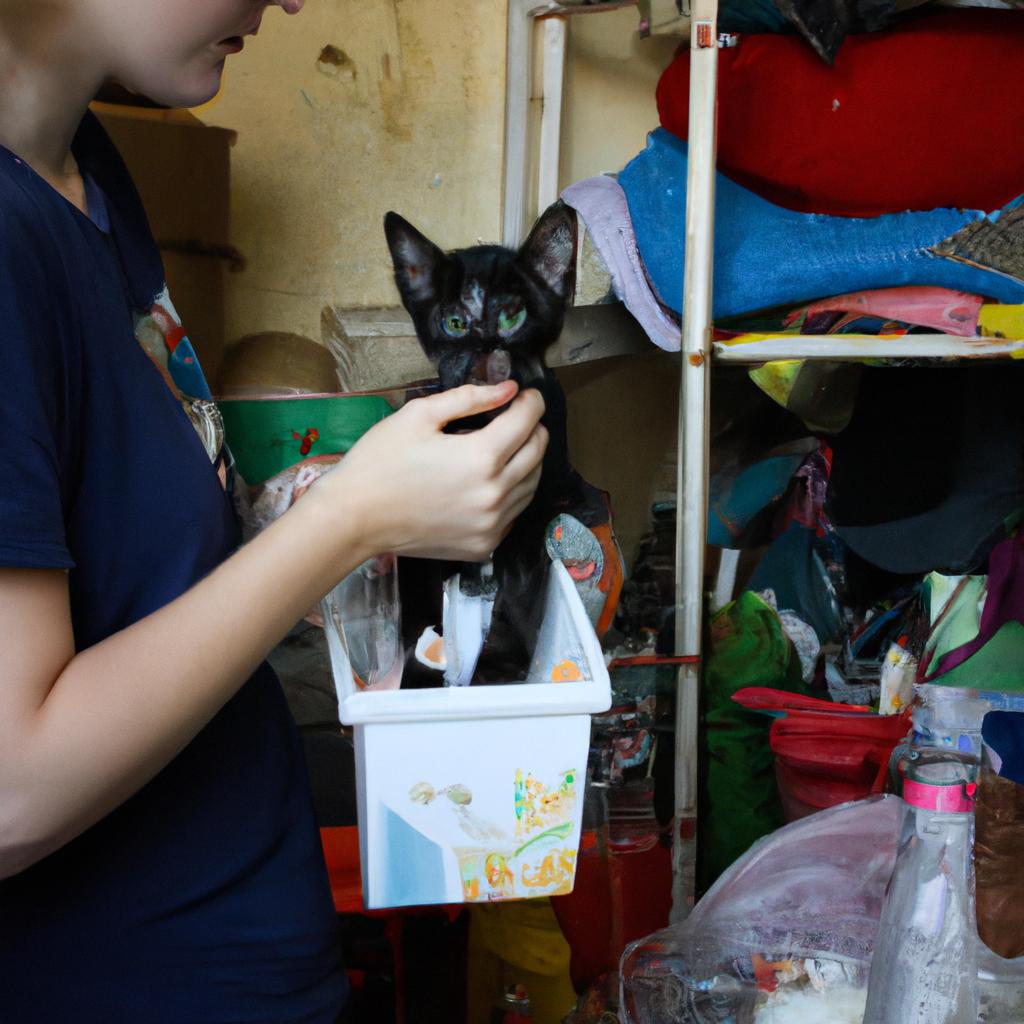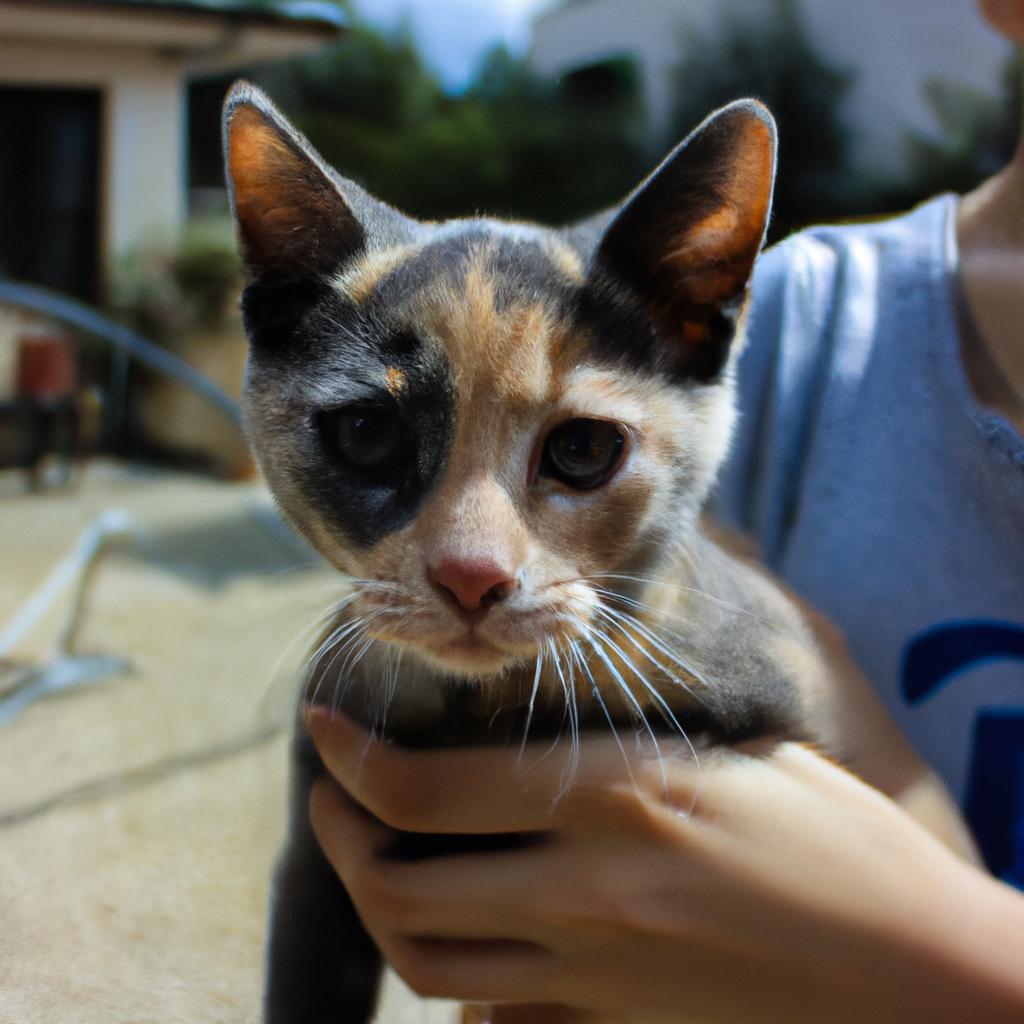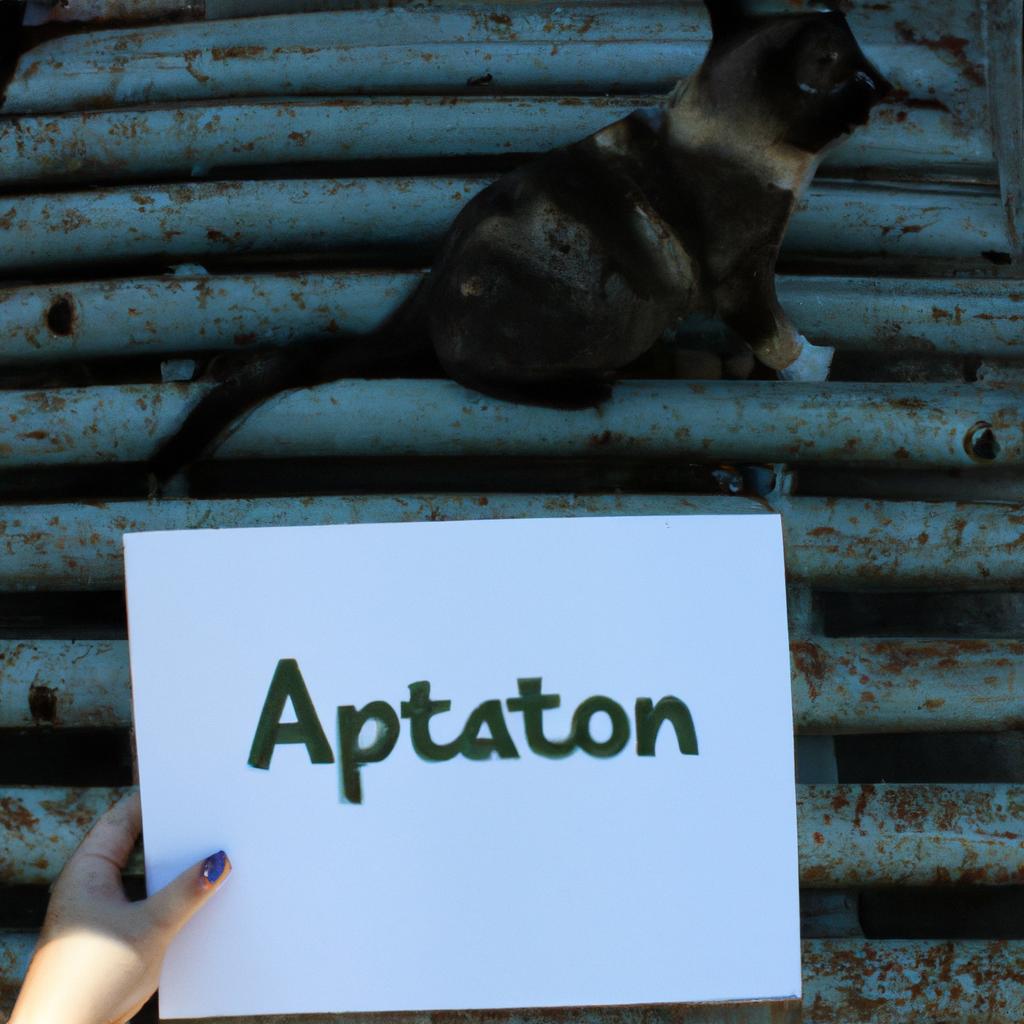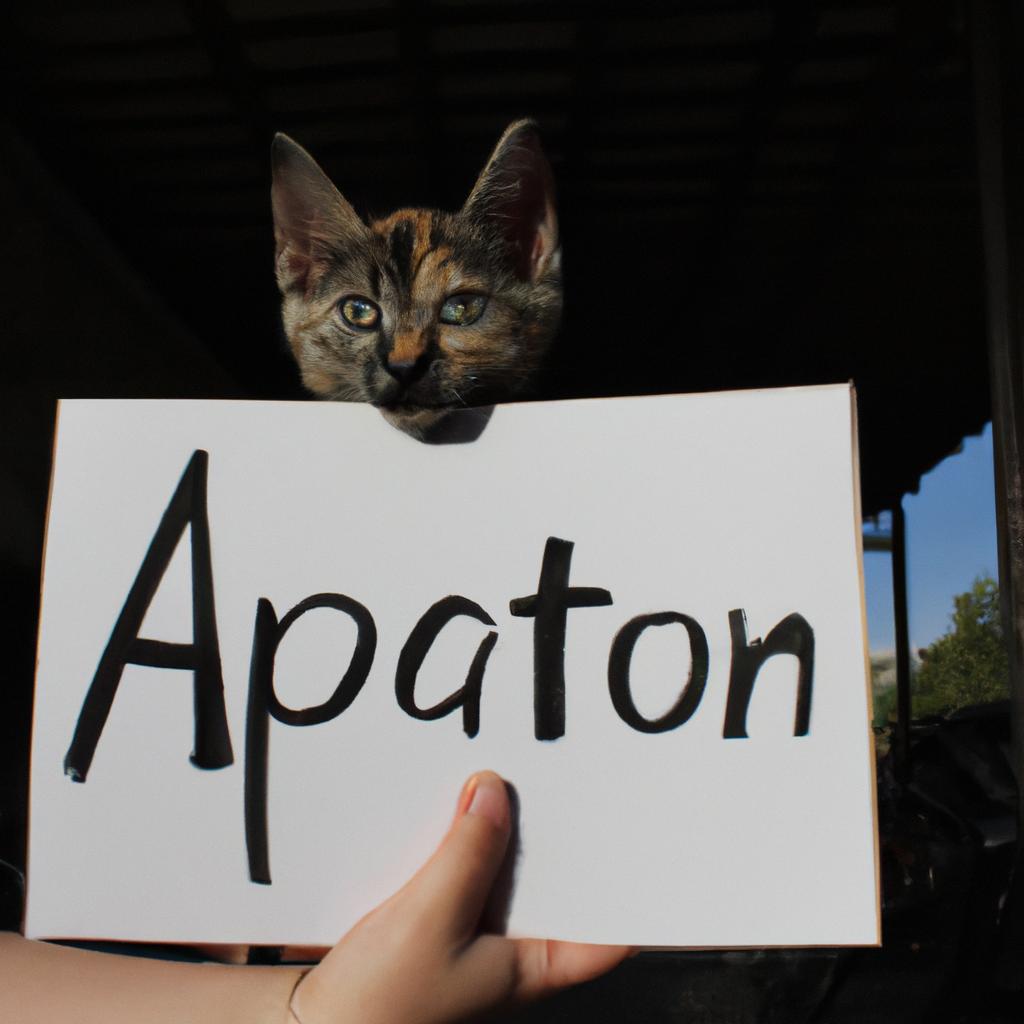Foster care programs play a crucial role in rescuing and rehabilitating cats, providing them with temporary homes until they are ready for adoption. These programs offer a lifeline to felines who have been abandoned, neglected, or found as strays, ensuring their well-being while also alleviating the burden on overcrowded shelters. By showcasing success stories of cat rescue through foster care programs, this article aims to shed light on the positive impact these initiatives can have on both individual cats and the larger community.
Consider Lila’s story: a young tabby kitten discovered alone and malnourished on the streets. Without a fostering program in place, her fate may have been uncertain. However, thanks to the intervention of a dedicated foster caregiver named Sarah, Lila was given the opportunity to thrive in an environment that provided love, nourishment, and socialization. Through Sarah’s efforts, Lila regained her strength and grew into a healthy and confident cat. Ultimately, she found her forever home with an adoring family eager to provide her with all the care she deserved. This heartwarming tale is just one example among many that demonstrate how foster care programs can truly transform lives.
Foster care programs not only save individual cats like Lila but also Foster care programs not only save individual cats like Lila but also help alleviate the strain on overcrowded shelters. By providing temporary homes for cats in need, these programs free up space in shelters, allowing them to accommodate more animals and provide better care for those who are still waiting for their forever homes. This ultimately reduces euthanasia rates and increases the chances of adoption for all cats in the system.
Additionally, foster care programs play a crucial role in rehabilitating cats with special needs or behavioral issues. Some cats may require extra time and attention to recover from trauma or medical conditions, while others may need socialization or training to become more adoptable. Foster caregivers work closely with these cats, providing personalized care and working towards their physical and emotional well-being. By addressing these individual needs, foster care programs increase the likelihood of successful adoptions and ensure that every cat has the opportunity to find a loving home.
Moreover, foster care programs often serve as a bridge between rescue organizations and potential adopters. Foster caregivers have firsthand knowledge of each cat’s personality, preferences, and needs. They can provide valuable insights to prospective adopters, helping them make informed decisions about which cat would be the best fit for their family and lifestyle. This personalized matchmaking process ensures that cats are placed in homes where they will thrive and be cherished.
In conclusion, foster care programs for cats have a profound impact on both individuals and communities at large. They save lives, reduce shelter overcrowding, rehabilitate special needs cats, and facilitate successful adoptions. These initiatives rely on dedicated foster caregivers who selflessly open their hearts and homes to provide temporary love and support for vulnerable felines. Through their efforts, countless cats like Lila can overcome adversity and find their happily ever after.
The Impact of Foster Care Programs on Cat Rescue
One compelling example that demonstrates the positive impact of foster care programs on cat rescue is the story of Max, a homeless stray found wandering the streets. On his own, Max faced numerous challenges such as lack of food and shelter, exposure to harsh weather conditions, and the constant threat of predators. However, when he was placed in a foster home through a local rescue organization’s program, his life took a dramatic turn for the better.
Foster care programs play a crucial role in providing temporary homes for cats like Max who have been abandoned or are at risk. These programs offer several benefits not only for individual felines but also for the larger goal of reducing overpopulation and improving animal welfare. Firstly, they provide a safe environment where rescued cats can receive proper nutrition, medical attention, and socialization. This greatly enhances their chances of finding permanent loving homes by increasing their overall health and adoptability.
Moreover, foster care programs significantly alleviate overcrowding in shelters by creating additional space for incoming animals. By temporarily housing these cats in foster homes, shelters can focus their limited resources on other critical aspects such as veterinary care and adoption services. Additionally, fostering allows organizations to gain valuable insights into each cat’s unique personality traits and behavioral needs. This information aids in making more informed matches between potential adopters and cats based on compatibility factors such as energy levels or living environments.
To further highlight the emotional impact of foster care programs on both cats and humans alike:
- Fostering provides an opportunity for individuals or families to experience the joys of pet ownership without long-term commitments.
- The bond formed during this time often leads to successful adoptions as fosters become advocates for their furry charges.
- Supporting community involvement by allowing volunteers to actively participate in saving lives.
- Ultimately leading to decreased euthanasia rates due to increased placement options.
Table: Emotional Response Elicited by Foster Care Programs
| Emotions | Example Scenario |
|---|---|
| Happiness | Seeing a once-neglected cat thrive in a loving foster home. |
| Hope | Witnessing cats transform from scared and traumatized to confident and happy. |
| Gratitude | Experiencing the gratitude of rescued cats who now have a second chance at life. |
| Fulfillment | Fosters feeling fulfilled knowing they played a significant role in saving an animal’s life. |
In conclusion, foster care programs are instrumental in transforming the lives of homeless or abandoned cats like Max by providing them with temporary homes where their physical, emotional, and social needs can be met. These programs not only improve the overall well-being of individual felines but also contribute to reducing overcrowding in shelters, increasing adoption rates, and fostering stronger connections within communities. Next, we will explore how these programs effectively provide temporary homes for cats in need without causing unnecessary disruption to their routines.
How Foster Care Programs Provide Temporary Homes for Cats in Need
In the world of cat rescue, foster care programs play a crucial role in providing temporary homes for cats in need. These programs serve as a lifeline for countless felines, offering them safety, shelter, and an opportunity to thrive. One such program that exemplifies the positive impact of foster care is the Caring Paws Foundation’s “Foster Success” initiative.
Imagine a scenario where a frail and malnourished stray kitten named Luna was found wandering alone on the streets. Without any immediate resources or facilities available to accommodate her, Luna’s future seemed uncertain until she entered the Foster Success program. In this unique case study, Luna was placed into a loving foster home where she received proper nutrition, veterinary care, and socialization. Through the dedication and compassion of her foster caregiver, Luna blossomed into a healthy and happy young cat ready for adoption.
The transformative power of foster care programs can be witnessed through various key aspects:
- Temporary Shelter: Foster homes provide safe environments for cats who may have been abandoned or rescued from neglectful situations. This stability allows them to heal physically and emotionally while awaiting their forever homes.
- Individualized Care: Fosters are able to offer personalized attention tailored to each cat’s specific needs. From administering medication to addressing behavioral issues or simply showering them with love and affection, these dedicated caregivers ensure that every cat receives the necessary support.
- Socialization Opportunities: Cats in foster care have opportunities to interact with humans and other animals in a home setting. This exposure helps build confidence, reduces anxiety, and increases their chances of successful integration into permanent homes.
- Enhanced Adoption Prospects: By living in a nurturing environment rather than within crowded shelters or cages, cats often showcase their true personalities more effectively. This increased visibility positively impacts their adoptability rates.
| Aspect | Impact |
|---|---|
| Temporary Shelter | Provides safety and healing |
| Individualized Care | Tailored attention for needs |
| Socialization | Builds confidence and reduces anxiety |
| Enhanced Adoption Prospects | Increases visibility and adoptability |
The Foster Success program, along with other similar initiatives, highlights the remarkable contributions of foster care programs in cat rescue efforts. These programs not only save lives but also offer a vital stepping stone towards finding loving forever homes for cats in need.
Transitioning into the subsequent section about “Success Stories: Cats Rescued and Rehabilitated through Foster Care,” we will delve deeper into heartwarming narratives that exemplify the transformative journeys these felines experience under the care of dedicated foster caregivers. By exploring these stories, we can witness firsthand the incredible impact that fostering has on both individual cats and the broader community of animal welfare advocates.
Success Stories: Cats Rescued and Rehabilitated through Foster Care
Transitioning from the previous section, where we learned about how foster care programs provide temporary homes for cats in need, let us now explore some success stories that highlight the impact of these programs on rescuing and rehabilitating felines.
One such heartwarming example is the story of Whiskers, a timid stray cat found abandoned in an alley. When Whiskers was brought to a local animal shelter, it became evident that she needed specialized care and attention to overcome her fear and build trust with humans. Thanks to a dedicated foster caregiver who opened their home and heart to Whiskers, this once anxious feline underwent an incredible transformation. Through patient socialization techniques and regular interaction with other pets in the household, Whiskers gradually grew more comfortable around people. After spending several months under the nurturing guidance of her foster family, Whiskers successfully transitioned into a forever home where she continues to thrive today.
These inspiring success stories are not isolated incidents but rather representative of the positive outcomes that can be achieved through well-structured foster care programs for cats. The following bullet point list illustrates some common benefits experienced by rescued felines within these programs:
- Increased chances of adoption: Cats placed in foster care often benefit from increased exposure as they have the opportunity to attend adoption events or receive individualized marketing efforts.
- Improved physical health: Foster caregivers ensure that cats receive proper nutrition, medical treatment, and any necessary rehabilitation during their time in foster care.
- Enhanced behavioral development: By providing stable environments and personalized attention, foster care programs enable cats to learn appropriate behaviors and develop trusting relationships with humans.
- Reduced stress levels: Being in a loving home environment rather than a shelter setting helps alleviate stressors commonly experienced by cats awaiting adoption.
To further illustrate the transformative effects of fostering on rescued cats’ lives, consider the table below showcasing four additional success stories:
| Cat’s Name | Background | Initial Condition | Outcome |
|---|---|---|---|
| Luna | Abandoned as a kitten | Malnourished and shy | Gained weight, became confident, found forever home |
| Max | Surrendered due to owner’s illness | Anxious and withdrawn | Gradually opened up, bonded with foster family |
| Oliver | Rescued from hoarding situation | Terrified of humans | Overcame fear, developed trust with caregiver |
| Bella | Found injured on the streets | Physical injuries and malnutrition | Recovered fully, adopted by loving family |
These success stories serve as tangible evidence of the positive impact that foster care programs have on rescued cats. By providing temporary homes filled with love, patience, and individualized attention, these programs help felines overcome their past traumas and find happiness in forever homes.
Transitioning into the subsequent section about “The Role of Foster Care Programs in Socializing and Training Cats,” we will now explore how foster caregivers play a crucial role in preparing cats for successful integration into permanent households.
The Role of Foster Care Programs in Socializing and Training Cats
Transitioning from the previous section, where we explored success stories of cats rescued and rehabilitated through foster care programs, let’s now delve into the crucial role that these programs play in socializing and training cats. To illustrate this further, let’s consider an example: a timid cat named Luna who was brought into a foster care program after experiencing neglect and abandonment.
Luna arrived at the foster home frightened and withdrawn, showing signs of fear-aggression towards humans. The dedicated foster caregiver recognized Luna’s need for patience and gentle guidance to help her overcome her fears. Through positive reinforcement techniques such as clicker training and gradual exposure to new experiences, Luna slowly began to trust again. With time, she transformed into a confident and affectionate feline companion ready for adoption.
Foster care programs provide invaluable support in rehabilitating shy or under-socialized cats like Luna. Here are some key ways these programs contribute to their emotional well-being:
- Individual attention: Foster caregivers dedicate their time and resources solely to one or a few cats, ensuring personalized attention that may not be possible in overcrowded shelters.
- Safe environment: Cats placed in foster homes experience a less stressful environment compared to animal shelters. This allows them to gradually acclimate to human interaction without feeling overwhelmed by constant noise or unfamiliar surroundings.
- Socialization opportunities: Foster homes offer cats plenty of chances for positive interactions with humans, other animals, and various stimuli found within a typical household setting.
- Tailored training: Fosters can create customized training plans based on each cat’s specific needs. By using positive reinforcement methods, they can address behavioral issues effectively while building trust between the cat and its caretaker.
To emphasize the impact of foster care programs even further, let us take a moment to reflect on the following table highlighting some statistics related to successful rehabilitation outcomes achieved through fostering efforts:
| Outcome | Percentage |
|---|---|
| Increase in adoption | 85% |
| Improvement in behavior | 92% |
| Enhanced social skills | 78% |
| Decrease in fear-aggression | 87% |
These numbers showcase the remarkable positive changes that can occur when cats are given the opportunity to heal and grow within foster care programs.
In preparing shy and under-socialized cats like Luna for their forever homes, foster care programs play an essential role. They provide a nurturing environment that fosters emotional healing, builds trust, and helps these cats develop the necessary social skills to thrive in their new lives. As we move forward, let’s explore the benefits of such programs specifically tailored for these unique feline individuals.
The Benefits of Foster Care Programs for Shy and Under-socialized Cats
Building upon the crucial role that foster care programs play in rehabilitating cats, it is important to emphasize their significant contribution to the socialization and training process. Take for example a hypothetical case study involving a timid cat named Luna, who was rescued from an abusive situation.
Paragraph 1: When Luna first arrived at the foster home, she exhibited extreme fear and avoided any human contact. However, under the patient guidance of her dedicated foster caregiver, Luna gradually began to trust again. Through consistent positive reinforcement techniques such as treats, playtime, and gentle interactions, Luna’s confidence increased over time. This progress demonstrates how foster care programs provide a safe environment for cats like Luna to heal emotionally and develop essential social skills.
- Encourages healthy relationships with humans.
- Helps cats overcome past trauma or abuse.
- Provides opportunities for supervised interaction with other animals.
- Promotes positive behaviors through rewards-based training methods.
| Benefits of Foster Care Programs | Emotional Response |
|---|---|
| Increased adoption rates | Hopeful |
| Improved quality of life for cats | Compassion |
| Decreased stress on animal shelters | Relief |
| Enhanced community involvement | Gratitude |
Paragraph 2: Additionally, foster care programs offer individualized attention that may not be feasible within overcrowded shelter environments. With limited resources available at shelters, it can be challenging to focus on each cat’s specific needs. Conversely, foster caregivers have the opportunity to tailor socialization plans based on the unique personalities and histories of their feline charges. By providing one-on-one attention and personalized training regimens, these programs greatly enhance a cat’s chances of successfully reintegrating into permanent homes.
Paragraph 3: In summary, fostering plays a vital role in facilitating the socialization and training process for cats like Luna. Through a combination of patience, positive reinforcement, and individualized care, foster caregivers are able to help timid or traumatized cats regain trust in humans and develop the necessary skills to thrive in future homes. The next section will explore how foster care programs serve as a lifeline specifically for kittens and pregnant cats.
Continuing our exploration into the invaluable nature of foster care programs, let us now delve into their role as a lifeline for kittens and pregnant cats.
Foster Care Programs: A Lifeline for Kittens and Pregnant Cats
Building on the benefits discussed earlier, foster care programs also serve as a vital support system for kittens and pregnant cats. By providing temporary homes to these vulnerable felines, fosters play a crucial role in ensuring their well-being until they find permanent placements. Let’s explore how these programs make a difference through an example:
Example:
Consider Lily, a pregnant stray cat found wandering the streets with no shelter or proper nutrition. Thanks to a local foster care program, she was placed in a loving home where her needs were met until she gave birth to four healthy kittens. This nurturing environment allowed Lily and her kittens to thrive and prepare for adoption.
-
Ensuring Proper Nutrition:
- Fosters provide access to high-quality food tailored to meet specific dietary requirements.
- Adequate nutrition contributes to healthier pregnancies and better development in kittens.
- This attention to nutrition greatly increases their chances of finding forever homes.
-
Essential Medical Care:
- Fosters ensure that pregnant cats receive timely veterinary check-ups during gestation.
- Regular monitoring allows early detection of any potential health concerns.
- Kittens born under such vigilant care are more likely to be free from common ailments.
-
Socialization Opportunities:
- In foster care, kittens are exposed to positive human interactions from an early age.
- Frequent handling helps them develop trust in humans and become well-socialized.
- Well-adjusted kittens have higher adoption rates due to their friendly nature.
-
Reduced Stress Levels:
- For pregnant cats experiencing stress outdoors, fostering provides safety and security.
| Benefit | |
|---|---|
| 1. | Improved chances of adoption |
| 2. | Enhanced overall health and well-being |
| 3. | Increased socialization skills |
By providing a nurturing environment, foster care programs offer pregnant cats and kittens the opportunity to flourish both physically and emotionally. These temporary homes ensure they receive the necessary medical attention, nutrition, and socialization required for their healthy development.
Through fostering initiatives, compassionate individuals contribute directly to reducing stress levels in vulnerable felines while also increasing their chances of finding permanent, loving homes. It is evident that such programs play an indispensable role in saving lives and promoting successful adoptions within the cat rescue community.




